Photo: Daniel Studio
This is part 3 in a series of posts based on PSP’s talk with Union head coach Jim Curtin. Find part 1 here and part 2 here.
In 2015, Philadelphia Union’s main wingers were held scoreless from the beginning of the season until May 30. At the time of his goal against DC United, Sebastien Le Toux had not taken three or more shots in a match since the opening day of the season. On the other side, Andrew Wenger had taken three shots just once, and he had accumulated a single shot on goal total over the previous six games.
Those numbers are very bad.
Wenger went from taking at least one shot on goal in eight of the final ten games of 2014 to taking zero shots on goal in seven of the first ten of 2015. Both Fabinho and Ray Gaddis had more key passes than Wenger, and Sheanon Williams equaled him in 17 total appearances.
OK, very, very bad.
Head coach Jim Curtin was in danger of suffering the young slugger’s curse. The young slugger arrives in the majors and crushes the ball. But major league pitchers quickly find the holes in his swing and soon the young slugger is taking the same frustrated walk Curtin took after each of the first 5 (winless) matches of 2015.
What did opposing teams figure out? Mainly, that while Curtin could organize a solid defensive shell and direct a sizzling counterattack, his team was slow to return to its shape and could be throttled if the first pass out of the back was effectively challenged.
It is impossible to say whether Curtin failed to adjust once his system had been properly scouted or whether the Union’s wingers simply fell in love with the idea of sitting high and wide. But what is clear is that Philadelphia were rarely dangerous from wide areas last season. The hard charging counterattack that briefly revived Wenger’s flagging career was replaced with a numbing lack of creativity.
Behind the wingers, the Union’s fullbacks were equally spartan in their contributions. It took Orlando City’s Luke Boden and Rafael Ramos 4200 minutes to reach 48 key passes; Philly’s fullbacks took 5600 minutes to combine for 44, or about one and a third per game.
In short, the Union need more — and more consistent — offensive contributions from wide areas this season. And a series of offseason moves point to the form Curtin and Earnie Stewart would like those contributions to take.
Tucking in
“The biggest difference that you’ll see from our two wide players is that, in the past, I would say they were referred to almost as midfielders,” Curtin told PSP. “We want them to be more outside strikers, would be the term I would use. Last year those guys were strictly wide and almost defended more than they attacked. They defended the other team’s outside backs. We were pinned back a lot.
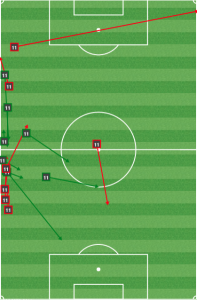
In a July loss to TFC, Andrew Wenger rarely left the touchline before Toronto’s opening goal.
“I want other teams to worry about them,” Curtin continued. “So when we are in possession, we’re going to ask them to come inside more. Inside, and pretty high.”
One way to think about this tactic is that the Union would like to dictate the overall shape of each match. By slipping the wide men tight in the final third, Philly can either gain a numerical advantage in the center or pull the opposition defense so tight that space is left on the wings for a fullback to sit like a hockey player on the half-boards during a power play, recycling play or crossing the ball into a dangerous area.
In a dynamic game like soccer, every consciously thought-out decision a defender has to make is an opportunity for the offense. If a center back sees that a winger is constantly tucking into the pocket between him and his outside back, he has to make a decision about whether to close the gap between him and the fullback or stay close enough to the striker to prevent effective hold up play through the middle.
“So now [the central defender]’s not looking at CJ, the center back has to look at Seba: Do I step to him, do I stay?” Curtin explained. “Again, it all comes down to making these guys deal with more than one thing. Outside backs in our league are athletic enough to know that if they’re always matched up against one guy, and he’s always going to be wide, and I know exactly where he is, they’re job is going to be easy.”
Mental work
Curtin talks a lot about wanting to make opposing central defenders run and do more physical work. But the unspoken goal of tucking wingers inside is to make defenders do more mental work. The more variability an offense throws at a defense, the more decisions defenders have to make. And it follows that more decisions means a greater likelihood of making a mistake.
This modern notion of forcing the defense to make decisions is mirrored by American football. Recently departed former Eagles head coach Chip Kelly ran a fast offense that sought to spread out a defense (sound familiar?). A well-designed offensive play in football forces at least one defender to make a decision about which receiver to follow or which gap to hit. In American football, coaches get to send in play after play as they search for that elusive matchup problem that forces a defense to put a linebacker on a fast receiver or make a safety choose between following the slot man wide or sticking with the tight end inside.
Soccer coaches don’t get to send in plays. They must build offensive systems that dynamically create questions and matchup problems for defenses, and they need their players to understand that tucking into a pocket may not get you the ball, but it puts you on a center back’s radar. And a mental radar can only monitor so many moving objects at once.
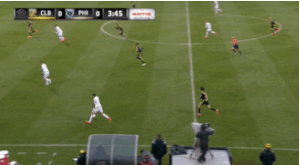
Against Columbus in April, Wenger attacks the defense centrally, collapsing it. But he runs out of confidence and plays a poor pass wide (click to play).
“So the ability to come inside now, from a Pontius, from a [Walter] Restrepo, a Seba, who has to do it more. To come inside and join in. Now you’re talking about a numbers advantage centrally,” Curtin said. “It also will involve, and we’ll need, our outside backs to play higher up and then take risks. In the right moments. I’m not going to say all of a sudden we’re going to become a team that’s playing a 3-5-2 or anything.
“It’s a commitment from those wide guys to come inside and make center backs and outside backs do more than one thing, and not just get comfortable and think all they have to do today is get comfortable with their center back partner and worry about CJ [Sapong]. They have to deal with Tranquillo [Barnetta] maybe making a deep run, CJ checking into the space that’s left if the center back steps in to deal with Seba. Part of it’s a belief, a commitment to get forward and a commitment to try and play in possession.”
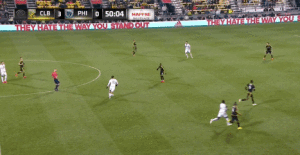
With his passing lane cut off, Le Toux heads upfield instead of checking in as an easy option for Maidana (click to play).
The evolving winger
Curtin’s vision is a modern one. Soccer has evolved from wingers-on-the-wings to wingers-cutting-inside to wingers-drifting-inside. Whereas wing players used to crash toward the endline, managers like Jose Mourinho and Pep Guardiola realized that playing with three central midfielders meant wide defenders would get less support from the middle.
A perfect storm of tactical evolution and talent created the juggernaut that was Franck Ribery and Arjen Robben during the heydey of Jupp Heynckes’ Bayern Munich teams. Those inverted wingers could roast any two players they faced, so leaving them alone with a single defender was like leaving a FIFA official alone with a bag of money. You know what is going to happen.
But most wingers are not Robben and Ribery, and beating fullbacks 1v1 is, well, hard. So managers avoid 1v1 battles by instructing wingers to drift into the pockets of space between fullbacks and center backs. Without pressure, any player receiving the ball in that zone can turn toward goal, dribble, pick out a runner, or play the ball wide to an advancing fullback without ever having to take on a defender.
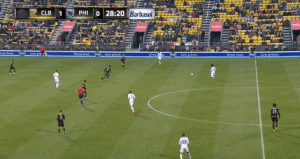
Le Toux wants to turn upfield instead of simply getting a touch and a foul. (Click to play).
Additionally, tucking in opens space on the edges during counterattacks because defenses seek to close those between-defender gaps and leave more grass near the touchline so wingers can still exploit the traditional channels in transition.
But there is a big caveat here, and Curtin is not blind to it. Wingers tucking inside, fullbacks pulling wide, and central defenders splitting wide in support all make it more difficult for a team to return to its defensive shape. If the wingers simply stay wide, offense to defense is a bit like going from a high-five shape with your hand to a fist: Everything gets closer together but all the fingers (hopefully) stay in the same arrangement.
In order to properly utilize modern wingers, the Union need to be much better in possession. “If you look at the possession, we weren’t good this year,” Curtin admitted. “But if you look at final third entries, we’re always up high in that.”
And it’s true. To the extent that Philly could successfully connect the first pass out of the back to start a transition, the team was good at getting into the final third. And in Cristian Maidana, they had a playmaker who could create scoring opportunities out of nothing. But possessing the ball in the final third? Not a quality to be ascribed to the 2015 Union. And that is likely one of the reasons Cristian Maidana will be pulling on boots in Texas this season.
Moving Maidana
Maidana orchestrated the attack by slipping out to the wings and poking the ball into the spaces he left behind. Maidana’s unique interpretation of the trequartista role is a more extreme take on the modern MLS playmaker role that requires a distributor to pull away from the opposing defensive midfielders to find creative space. The Union man simply went further, attempting to create a numbers advantage against the other team’s wide men or pull a central midfielder out of position.
Maidana’s movement may have contributed to the low production numbers of the fullbacks, who tended to look for the Argentinian rather than push forward themselves.
Mitigating factor or excuse, Maidana’s movement will not be part of the Union’s 2016 season. Instead, Tranquillo Barnetta’s more vertically-oriented game will require larger contributions from the wide players in the offensive third.
Maidana’s style cannot be the lone villain in the story of Philly’s possession problems. Last year, the Union wingers would tuck inside but stay high against the opposition’s back line. Such positioning is fine if the goal is to check back into space or peel wide to open a gap for a runner. But for Le Toux and Wenger, it appeared to be more about anticipating a ball over the top and cheating that way. Not only did this remove them from the possession game, but it neutralized the advantage they would get by getting a running start on the defense when chasing a long ball. It made defenders’ jobs much, much easier. So much easier that Eric Gehrig, a player who, on paper, has no right making Andrew Wenger look unathletic, shut the Union winger down to such an extent that he was able to successfully trash talk PSP after the match.
More goals
Wenger’s inability to adjust when team’s closed down his 2014 route to goal was disappointing, but it should not overshadow Sebastien Le Toux’s slow but steady learning curve on the other side. Le Toux did not get his first goal until May 30, but he finished the season with eight tallies (almost a fifth of the Union’s total).
When he was effective, Le Toux was involved in build-up play and got to the box to follow up crosses and collect failed clearances. Whether these adjustments were Le Toux’s own doing or tweaks made by the coaching staff is unknown, but it’s clear that Curtin believes Le Toux and newly acquired Chris Pontius can replicate that level of offensive input in 2015.
“I do believe Pontius, if he stays healthy, he does have a track record of being in that 6-8 goal range, I think that would be a strong contribution,” Curtin said. “And with Seba, you just want it to be consistent. He has a way of getting hot and carrying the whole team’s scoring load for stretches.”
Pontius has scored a total of six goals in three injury-riddled seasons since his breakout 12 strike campaign of 2012. But the system Curtin is proposing does fit the player’s style. The big theme of the Union’s offseason roster building has been finding guys like Pontius who may not make the biggest headlines but fit the style Philly wants to play.
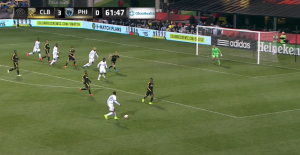
Gaddis can cross with four Union players in the box. Instead he elects to go to the touchline.
However, this notion of finding the right guys for the system raises some red flags when it comes to the fullbacks.
The fullbacks
Essentially, the Union can suck their wide players inside and create a rotating diamond with Barnetta and Sapong building connections. To maintain width, Philly will push the fullbacks higher. The goal in all of this is sustained pressure of the kind that the Union rarely developed last season. But Philly’s fullbacks have a lot to prove on this front. Fabinho is comfortable on the ball, but he’s even more comfortable crossing the ball, especially from deep positions where most fullbacks would look to play short. Gaddis is not comfortable on the ball and struggled for much of the season to find a role in the offense.
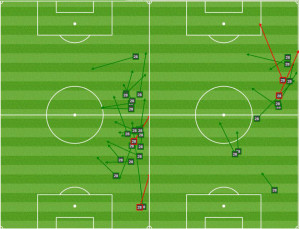
In an August match against OCSC, Gaddis pushed forward to support Ayuk once Maidana vacated the space modern fullbacks usually use (1st half on left).
“When Ray and Fabi get forward, they have to make good decisions,” Curtin said. “If that means cutting a ball back to keep possession, maybe we get a chance at the top of the box that way, that’s part of it too.”
The outside back’s role in the Union’s new system may require the least amount of explanation. They need to do three things well: Provide an outlet for that central diamond, provide quality service, and balance service and possession retention. If the Union’s wingers are in the right spaces, the opposition defense will have to sit deeper to minimize those gaps. This will provide more room for Vincent Nogueira and Maurice Edu in deeper areas, and the fullbacks will be responsible for finding the midfielders quickly. Recycling play through deep-lying midfielders means holding pressure on a defense, whereas recycling play through the center backs — which the Union did quite often last season — means allowing a defense to rest and reset.

Wenger chooses to cross into an empty box rather than try to retain possession. Click to play.
Philly’s fullbacks may have a straightforward job in 2016, but it isn’t an easy one. Teams have access to game tape, and they know that Gaddis can be pressured into giveaways and Fabinho can be induced to cross the ball. Especially early in the season as the Union struggle against falling into old habits when the going gets tough, be assured that there will be times when the ball is served into the box because it feels safer than trying to pass out of danger.
Curtin is fine with that, provided his team shows a commitment to get on the end of crosses. “One of the things I want to stress this year, no matter when we get the ball wide, at the top of the box, I want a minimum of three guys committed to get in the box,” the Union coach intoned. “A lot of the time when you go through the film now, you see CJ running hard in there by himself. There’s not a real commitment there from the weak side striker to come in and join in, and a midfielder late running hard. Not just jogging into the box, if it comes to me ‘Great!’ and if not ‘not great.’ You can train that, you can practice that.”
The Union did not use width effectively last season, but their counterattacking plan left little room for spreading and attacking a set defense. This year, a renewed commitment to holding possession requires Philly’s wing players to be mobile and creative off the ball. And it demands that the incumbent fullbacks make big strides in their offensive decision-making.
Tomorrow we will tackle the middle of the pitch.
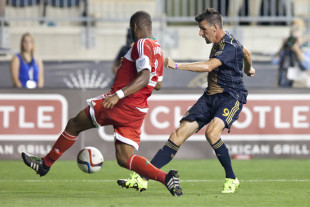

Adam, please keep the tactics articles coming!!!!!
Agreed!
Nice, thorough analysis, I’m really enjoying this series. Thanks. I of course would love to see our wide players playing high and pinching in, giving CJ some help and creating trouble for defenders. But, as Adam points out, the caveat is everything. Can we hold the ball consistently enough in the MF to create the time and space to make it happen? Time will tell, but Barnetta and Nogs teaming up with CJ who holds off defenders with the best of them gives some cause for optimism.
Loving the plan on paper.
.
But it will not be fully operational for another 2-3 seasons. Better possession, high press, playing out of the back….all will take time to get the right players and bring them together to do it.
There’s that patience again. Sound.
Great article. Love the insights. My only question about the wingers (or outside strikers) drifting in centrally is that the other team’s fullbacks will tuck in with them creating a very tight back four (i.e. your tight fist analogy). If the Union fullbacks don’t provide the necessary width to stretch the defense horizontally then the Union offense could find themselves having to continually go through a tightly spaced back four.
“One of the things I want to stress this year, no matter when we get the ball wide, at the top of the box, I want a minimum of three guys committed to get in the box,” the Union coach intoned.
.
Music to my ears.
You mean you don’t like blind crosses into an empty box? You have your priorities out of whack…
.
.
(heavy sarcasm, just to be clear.)
Which means you need to upgrade the defense because it will get caught out of shape by the opposition’s first pass after taking possession.
.
Hopefully that upgrade is taking shape.
True, although the positions in question were way up the field last year too, just all went/stayed wide instead of getting in the box.
Preferably with one being a late runner.
This is one of the main reasons Maidana is gone. I loved watching the guy sling passes, truly. But he was allergic to the box.
+1
Thanks, Adam. This is the kind of insight I read this site for.
I join in the heartfelt appreciation, as well.
To anyone from the Union:
Hi, I’m a devoted fan. I usually am unable to make it to games, for various reasons. So I spend most of my time watching on television. Your T.V. crew needs work. J.P. Dellacamera does a great job for you. But Peter Papas leaves much to be desired. You’ve had good teams in the past, J.P. and Moreno, J.P. and Taylor Twellman. But the sportscasting has gone boring with J.P. and Papas.
.
Solution? Right here you have a gentleman named Adam Cann. If you haven’t been paying attention, and I’m betting you haven’t, Adam here, is probably the best soccer analyst in our area. If not the East Coast. Now this may sound like a stretch to you, but all you need to do to assure yourself that this is the case, is just read the three in-depth articles he has written this week. If that’s not enough, feel free to peruse this site to find more fine examples of his work.
.
If you can’t find it in your heart to let Papas go, then I suggest adding Adam to the pre, post, and halftime segments. You are really doing yourself, your viewing audience, and any potential Union fan a disservice by not finding someway to get this man involved.
.
Sincerely,
A concerned Union fan.
Second.
i might not be remembering correctly but i think adam lives in texas? i thought i remembered someone from psp being at the open cup game against dallas. otherwise i agree
I’ll put down $50 towards his plane ticket home. The Union can pay the relocation fees.
He lost a bet. Now he lives in Lubbock.
Temporarily housed in Lubbock, sir! Temporarily housed!
You saying temporarily keeps my hope alive.
+1
I even like inverted wingers tucking in more.
.
Adam excellent piece and you eloquently sum up for me why futbol is so much better than football…. oh hey look 22 guy standing around waiting… I respect Classical music for its structure is but I love jazz…. Acid, Bop, Fusion, bluesy figure it out as we go.
“He likes having the ball, playing football, passes. It’s like an orchestra. But it’s a silent song. I like heavy metal.”
.
-Jurgen Klopp commenting on the difference between himself Arsene Wenger.
Beethoven and Brahms have both the structure of the Baroque and the passion of the Romantics. I commend them to your attention. 😉
Indeed~ I’ve listened and I have tremendous respect for classical music ~ enjoy Mahler and Ravel ~ more so than NFL football… but for me as I’ve mentioned its Coltrane in Berlin, Miles Davis’, Bags’ Groove and a bunch of guys improvising in a corner bar to low light a female soprano and cigarettes.
.
I too like these articles, they are very insightful, thanks.
My issue is that Curtin is talking as though last season it was the players staying wide on their own. Ayuk had no problems moving inside, neither did LeToux. I am having trouble believing that LeToux regularly decided, on his own initiative, not to crash the net and move inside, as opposed to be told to stay wider. I think it is great that we now have a plan, but it is revisionist history to suggest that what didn’t happen last year (goal scoring) was not the result of some plan of Curtin’s that just didn’t work.
Thanks for saying what I was thinking. A lot of these pieces are Curtin saying what players did wrong last year. Why didn’t he do anything then if it was so recognizable?
A bright light recently descended over him and enlightened him with the vision of good soccer, as the light faded away there Stood MR. Eanrie Stewart.
Well, maybe not quite that way.
Hope this analysis continues once the season starts. Can’t wait for preseason to start to see if they can play this style with any consistency.
It all starts at the back.
No worries about Adam. This is just par for the course. Watch for his in-depth analyses after every match. They are just as informative.
All4U is correct in my opinion. Do not ignore the pre game tactical analyses either.
Thanks OSC for adding the pregame. My recreation abused brain is not what it used to be…
You guys are too kind. I’ll just add: Please keep the comments coming. A lot of the time, I’m writing about topics that either start or are developed in the comment sections of these articles.
All too often people are told about the things they do wrong. Far less, are they told what they do well. You earn your praise sir.
First off, great article again. Second, I’m excited about the proposed changes in philosophy, tactics, etc.
Two questions that come up regarding this width topic:
1) Can LeToux play this way, tucking in as part of a diamond tasked with holding possession, cycling the ball out and back across, etc.? I certainly like the idea of him tucking in more and getting him into a pseudo-striker role attacking the box more.
2) This diamond top 4 concept with high charging backs puts a ton of pressure on Nogueira and to a greater extent, Edu to really be positionally sound. Any concerns there? It would certainly require a strong partnership between those two guys to make sure there’s cover for the CBs, as well as a reduction in Edu’s tendency to wander a bit. I know he’s capable, but does it happen?
#1: I think he can do it.
#2: Damn good question. I’m on a wait and see with this one.
The hope with Edu is that now that Earnie has a system with well-defined roles, he understands he needs to do his job and nothing more.
.
Edit: And if that was not something he understood, that he would have been sold like Maidana.
Same answer for both. I think they *can* do it. Whether they actually *do* do it (even during the tough games) will go a long way to telling us about Curtin as a coach.
Observations from this morning’s Open Practice at YSC. All points have the caveat that my eyes are not what they used to be, especially at a distance.
.
If others were there, did you recognize Vincent Nogueira?
.
A conversation with a younger member of the Academy’s school revealed that the practice occurred during a normal academy training time, so they were in fact not cutting school as I had feared. The older kids from the academy were the third group of players who brought the total,number to 35 by my hasty count.
.
The three tiers present were all integrated together into four groups, after a highly creative series of warm up exercises. I liked the ramifications of the seamless integration.
.
The four groups first played 6 or 7 v 2 in 11 yard squares with restrictive conditions and then changed to the familiar 3v2 attack transitioning to the 4v3 counter attack with keepers cross field alternating with shooting exercises.
.
The most valuable time for my interests was at the end when they went as close to full field,as you can at YSC indoors. THe width was 75, of course the length was much less than 125. The older players who are certain first teamers went elsewhere to a gym to work on strength flexibility and conditioning I presume. And three groups of eight plus keepers rotated against each other with the third group in the other part of the building doing I know not what.
.
Judging by the relative strengths of the three groups, one was stronger than the other two, so I concentrated on identifying them, primarily by listening to the goalkeepers call names. Each team played the same formation, a 4-3-1.
.
For the “best” group, as best I could hear, they aligned as follows: left back – “Taylor”. Left center back – “Kenny”. Right center back – “Josh”. Right back – “Keegan”. As you would expect when in possession, one or both outside backs were advanced up the field. The three midfielders were more fluid than the backs. The center mid, playing more defensively in front of the CBs than the other two was called “Bull” or “Bulla”. The other two midfielders were called “Leo” and “Josue”. The striker was referred to by a coach during an instructional hiatus as “Herbers”.
.
Prior to the beginning of this phase, Jim Curtin had a private word with the man I took to be Anderson Conceicao, and that player played for the second group in the back line on the left side, interchanging with some degree of fluidity between center and outside. My guess is that the coach was explaining the lineup choices to the player so that the player would read no unintended messages into the choices.
.
The man I took to be Richie Marquez exhibited a confident, expansive, forcefull personality when playing.
.
Standing directly above John McCarthy allowed me to hear him communicating with his back line and midfield. He is confident, forceful, and seemed smart. It helped me understand Curtin’s valuation of him. Blake also was assertive. I assume the bearded keeper was Samir Badr, and the fourth one was Andrew Verdi from the academy.
.
I have tried to stick to observed fact rather than the conclusions and inferences I instinctively drew, so others are more free to draw and make their own.
OSC, thanks for taking the time to share. It is indeed informing. Please don’t hesitate to do it again.
Glad to be of service.
.
In many ways this is the most stimulating time of year because we are all grasping for this nugget and that nugget to try to figure out what the devil they are up to, what our season will be like as fans/nuts.
+1 I haven’t felt this excited about the unknown possibilities of this team since the first two seasons. I was there at the open practice, I had no idea I was in the presence of the Old soccer Coach. Shame I would have liked to have met you. Thank you for sharing your observations.
Josue is an academy kid and he equipped himself well.. another academy kid Santos played strong as well so that was nice to see.
.
Keegan played well.. I found Herbers to be dispossessed quite a bit today in the 9v9 and in the 3v2 4v3 game….could be adjusting to the speed of game.
.
Noguiera was there… quite day from him even in the rondos… very business like…a serious day today as Leo mentioned but a lot of laughing too during warm ups and the rondos…
.
I did not see Pontius… Anyone confirm?
It seems that coach C is pretty clear about his defense, but sounds abstract about the offense, relying on old chestnuts like 3 in the box,fullbacks crossing it in ,pockets of space blah,blah. Offense is soooo difficult to establish and execute.Coming inside by wingers without a VERY specific purpose and choreographed movement can only benefit the defense.Predictable crossing by fullbacks can be primitive and innefective. Attacking down the sides with the fullback must involve 3 players to set up one of those players to shoot the gap between the central and outside defender with a vertical pass.Because the MLS is pretty inefficient, a fullback in the attack that turns so static that he has to cross the ball allows the defensive team to “cheat” and counter. Why not? statistical inefficiencies should be exploited.Paradoxically, the more people you have up front, the easier it is to defend and counter.SO be careful about wanting more attackers.The key is not the number but how they move. Think of scrawny little Pipo Inzaghi exploiting those packed defenses and the manner in which he did it. There is an answer in there.You can NOT posses the ball because you would like to, that nirvana comes with VERY specific preparation. Does Coach C know how to do it?That picture of Gaddis crossing the ball in might be the best way to bail out the defense.Think about UEFA 2012 with Ribery and Robben playing . Corners being a type of cross, Bayern 20 crosses, Chelsea 1. Maybe the coach could use some support regarding effective attacking schemes. His heart is in the right place but it sounds kind of vague at the moment. Although there still is snow on the ground so maybe more time is needed.
Inzaghi. Genius.
.
Did Nogueira have facial hair, and longer hair that made him seem darker than normal? I had thought that person might have been Pontius.
.
Sorry I am so bad with visual recognition these days.
He was..
.
That informs us how difficult it is to do what he did.
.
I would encourage us to take heart that the sporting director was a striker and may be able to help a former center back learn how to teach offense. For all we know he may step onto the pitch occasionally to do things like that. I’d like to think that Jim Curtin is man enough to seek help when he needs it; I have every confidence that he tries to remediate his self-perceived weaknesses.
.
Earnie Stewart’s emphasis on an individual plan for each player based on the player’s particular individual characteristics is not likely restricted to only players, is it? I would suspect the same plans exist, or will exist, for his coaches as he gets to know them.
Agreed, I believe you are on the right track. I can’t imagine Stewart not taking advantage of individual coaches positive strengths to benefit the entire coaching staff, thus improving the teams performance has a whole.
I love the system he wants to employ, but Fabinho does not have the discipline and Gaddis does not have the talent to successfully pull this off.
Our CBs, assuming that Mo is a disciplined CDM, have the athleticism to compensate for one poor fullback, but not two. I don’t think it is a stretch to say that Rosenberry’s development could make or break this season. If we can have one fullback that is disciplined defensively and has attacking prowess, we’ll make it to the playoffs. If we have the fullbacks of last season, this system is going to be a complete disaster and will probably cost Curtin his job.
I believe someone already pointed this out, but I will say Chaco’s trade should be an example to the entire team. Play within your role or We’ll Roll you out of town. From his interviews I would not want to test Mr. Stewart on whether or not he would trade me if, I didn’t confirm to the role I was given to play.